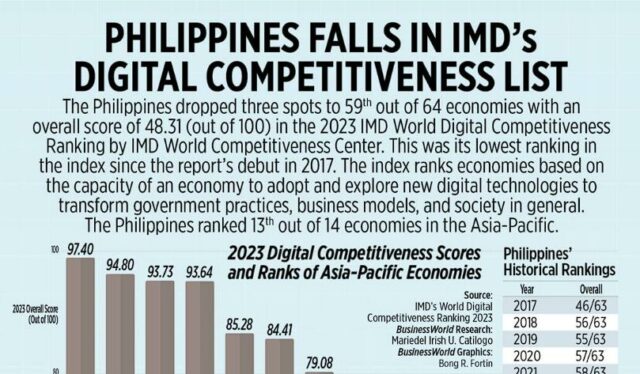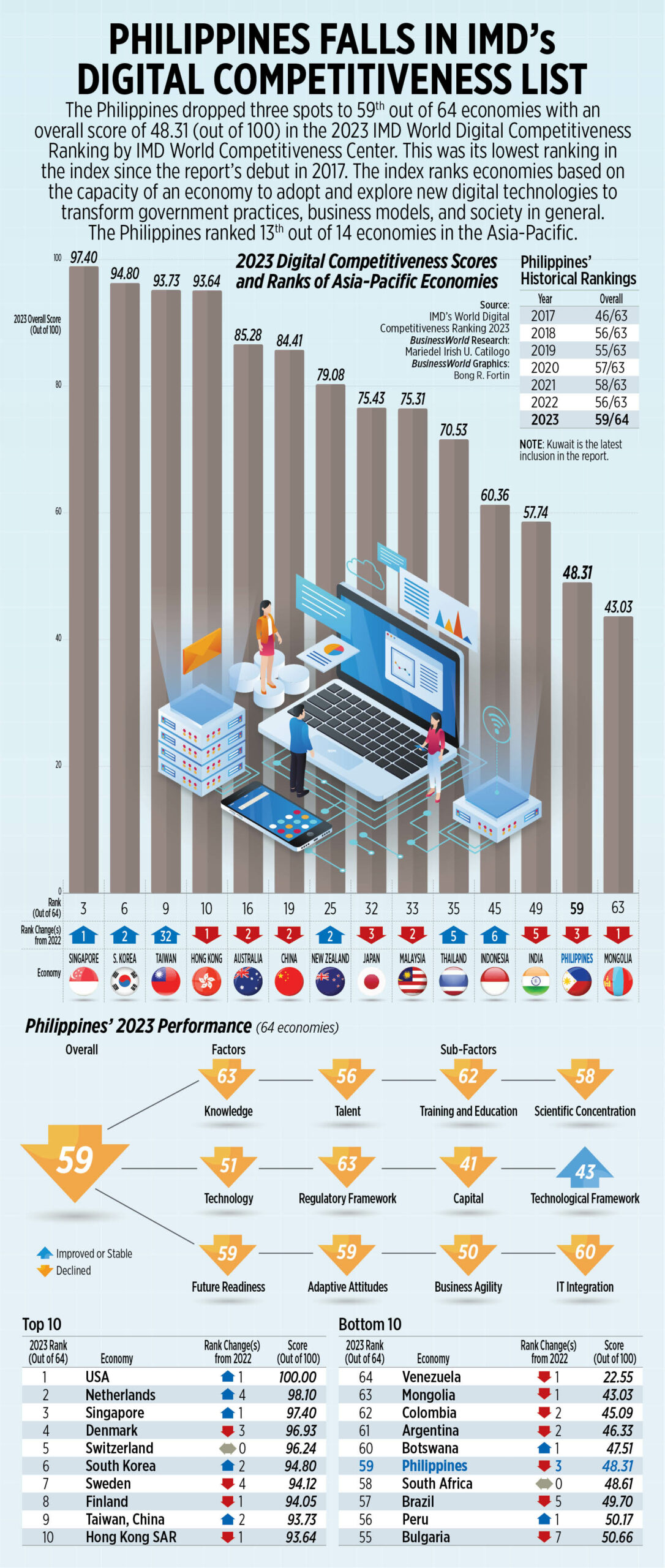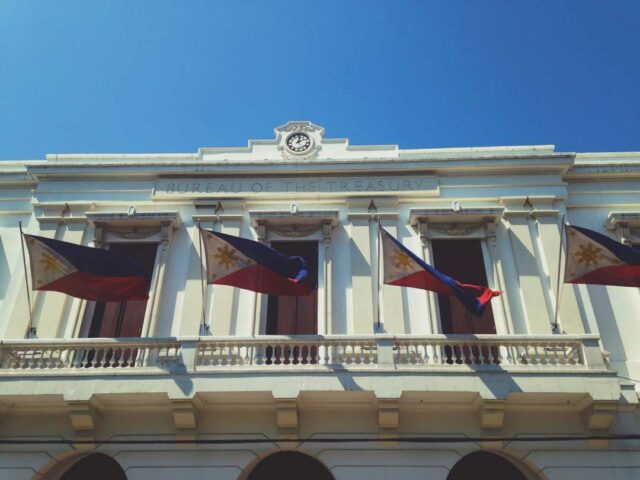MANILA – Shortly after winning the presidency of the Philippines in May of last year, Ferdinand “Bongbong” Marcos Jr. took his first congratulatory call from a foreign head of state.
US President Joe Biden was on the line.
Mr. Biden’s speed in wishing the new president well delighted Marcos, according to brother-in-law Gregorio Maria Araneta III, who said the Philippine leader proudly told his family about that call a few days later over lunch. It “put a smile on his face,” Mr. Araneta, one of the country’s most prominent tycoons, told Reuters in a rare interview, speaking from his wood-paneled office in Manila.
The US embassy in Manila confirmed Mr. Biden was the first to call. What followed was two trips to the United States in less than a year for Mr. Marcos, and visits to the Philippines by high-ranking Biden administration officials. Among them: Vice President Kamala Harris, Secretary of State Antony Blinken and Secretary of Defense Lloyd Austin.
Manila-based political analyst Julio Amador III described the US outreach as “unprecedented love-bombing” aimed at resetting the US-Philippines relationship. Mr. Marcos’ predecessor, the populist firebrand Rodrigo Duterte, was openly hostile to the United States and attempted to bring his country closer to communist China during his six-year term.
There is urgency to the US charm offensive: America needs Manila squarely in its camp as tensions with China rise in the Asia-Pacific.
The Philippines, Taiwan’s neighbor to the south, would be an indispensable staging point for the US military to aid Taipei in the event of a Chinese attack, military analysts say. China’s ruling Communist Party views democratically governed Taiwan as an inalienable part of China and refuses to rule out force to bring the island under its control.
Under President Xi Jinping, Beijing has laid claim to an ever-widening swathe of the South China Sea and is bent on making his nation the unquestioned military power in East Asia. Such a shift would have far-reaching consequences for US influence, regional security and global trade. More than a fifth of the world’s shipping passes through the South China Sea annually. The narrow straits around the Philippines and Taiwan bristle with undersea internet cables and are vital channels for US naval forces patrolling the region.
Reuters has been detailing the race between China and the United States to bulk up on advanced technologies that could determine who secures military and economic supremacy this century. Aerial and sea drones, AI-controlled weapons and cutting-edge surveillance are fast reshaping warfare, with implications for the global balance of power.
For the United States, cementing alliances in the Asia-Pacific region is likewise crucial to keeping China in check. The US embrace of Mr. Marcos is key to that project.
To get inside the American effort at mending ties and Marcos’ decisive pivot to Washington, Reuters spoke to more than two dozen current and former officials from both countries. Some spoke on condition of anonymity because they were not authorized to speak to the media.
The reporting revealed a picture of a superpower anxious about China, knocked off stride by Mr. Duterte, and eager to partner with Marcos despite his family’s history of brutality and corruption.
Mr. Marcos’ father, the late strongman Ferdinand Marcos Sr, was a steadfast US ally who was deposed in 1986 after Filipinos revolted against his regime. The elder Marcos was accused of orchestrating the detention and killing of thousands of political enemies and illegally siphoning billions of dollars from public coffers. He died in exile in Hawaii in 1989 without facing trial. After his death, family members returned to the Philippines, where they have remained a force in politics.
President Marcos did not respond to requests to be interviewed for this report. He has sought to recast his father’s time in power as a golden era of development for the Philippines, while saying little about the allegations of wrongdoing. “Judge me not by my ancestors, but by my actions,” he said after his 2022 election win.
The US State Department declined to comment on the Mr. Marcos family’s past. In a statement to Reuters, it said US support for civilian security, democracy and human rights was “integral to US foreign policy and national security interests” in the Pacific. “The US-Philippines alliance is strategically irreplaceable, and a Philippine government that respects the rule of law, good governance, and human rights is essential to maintaining a strong alliance.”
Reuters also learned of efforts by senior Filipino military and government officials that successfully stalled moves by Mr. Duterte to shred the US-Philippines security alliance. The reporting also sheds light on Marcos’ calculus about the risks of aligning himself too closely with China.
Mr. Duterte’s pro-Beijing stance was unpopular with the Filipino public, failed to produce as much Chinese investment as he had promised, and didn’t stop territorial disputes between the two nations, which have intensified
In October, the Philippines alleged that a Chinese coast guard vessel and a maritime militia boat “intentionally” collided with two Filipino boats on a journey to resupply Philippine personnel stationed at Second Thomas Shoal, a contested outpost in the South China Sea. China claimed that the Filipino vessels were at fault.
The United States swiftly backed the Philippines, warning Beijing that it would defend its ally in the event of an armed attack under a 1951 mutual defense treaty.
It’s a stance that pleased Manila, which has felt at times that Washington hasn’t done enough to support the Philippines in such confrontations, two current and one former official told Reuters.
Mr. Duterte declined to comment for this report.
China’s Foreign Ministry, in a statement to Reuters, characterized China and the Philippines as “close neighbors across the sea” with a common interest in friendship. It noted that China was the Philippines’ largest trading partner and a major source of investment that “had improved the living standard of the Filipino people.”
Without naming the United States, the Foreign Ministry added that “some countries, out of self-interest and with a zero-sum mentality, continue to strengthen their military deployment in the region, which is precisely aggravating tensions.”
Regarding Taiwan, the statement said China “insists on striving for the prospect of peaceful reunification with the utmost sincerity and effort, but will never commit itself to renouncing the use of force.”
‘HOUSE OF CARDS’
The Philippines is a former American colony that was granted independence in 1946, shortly after World War II. As part of the so-called first island chain ─ a string of islands that encloses China’s coastal waters ─ it has long been a key node in US defense strategy in the Pacific.
In addition to the Philippines, the United States for decades has partnered with other regional allies, including Japan, South Korea and Australia, to access military bases and conduct naval exercises. The enduring US presence has rankled an increasingly militarized and confident China.
The People’s Liberation Army now has a sophisticated missile force designed to destroy the installations, aircraft carriers and warships that are the backbone of American power in Asia. China boasts the world’s biggest navy. It has stepped up “grayzone” operations at sea – aggressive military actions that fall short of acts of war – especially around Taiwan and in contested waters of the South China Sea.
War games staged last year by think tanks including the Center for a New American Security (CNAS), based in Washington, illustrated how indispensable the Philippines would be for a US defense of Taiwan.
US access to Philippine runways and aircraft fuel proved vital in scenarios showing a successful repulsion of Chinese forces in the early days of a conflict, said Becca Wasser, a defense analyst and wargaming expert who ran the exercises for CNAS and has done the same for the US Department of Defense.
“I think that crystallized how important the Philippines could be and how, in some ways, relying on Japan and Australia, which are farther away, is just not enough,” said Ms. Wasser, who leads The Gaming Lab at CNAS.
But the US-Philippines relationship was strained with the 2016 election of Duterte, nicknamed “The Punisher” in the media. He quickly launched an anti-narcotics crackdown that resulted in extrajudicial killings of thousands of suspected criminals, a policy that raised alarms in the administration of President Barack Obama. Duterte also set about moving his country closer to economic powerhouse China, whose leader Xi shares his criticism of a US-led world order.
In October 2016, Mr. Duterte traveled to Beijing and proclaimed a new era of Sino-Filipino cooperation. “America has lost,” he told an audience of Chinese business executives. “I’ve realigned myself in your ideological flow.” Mr. Duterte returned to Manila with $24 billion in commitments under the Belt and Road Initiative, a global investment project that Beijing has used to wield soft power. Only a tiny fraction went ahead, according to the Philippines National Economic Development Authority.
Hostilities peaked in early 2020 after the United States canceled the visa of Senator Ronald “Bato” dela Rosa, who had spearheaded Mr. Duterte’s drug war in his previous post as head of the Philippine National Police. On Mr. Duterte’s orders, the Philippines notified Washington of its intent to terminate the Visiting Forces Agreement (VFA) within 180 days. Ratified in 1999, the pact sets rules for rotating thousands of US troops into and out of the Philippines. The VFA is key to implementing the bedrock Mutual Defense Treaty of 1951 that requires the United States and the Philippines to support one another in the event either is attacked in the Pacific.
Mr. Dela Rosa did not respond to a request for comment. At the time, he said the cancellation of his visa was the latest in a list of “gripes and disrespect” by the United States.
A retired senior Filipino military officer who served during that time recalled that US officials were “very worried, they thought everything will be like a house of cards falling.”
The Americans “saw the increasing influence of the Chinese” over Mr. Duterte, the officer said.
BLOCKING DUTERTE
But behind the scenes, the Philippine military establishment was pushing back against Mr. Duterte’s efforts to chip away at the US alliance, the Filipino military official and six others told Reuters.
US-Philippines cultural ties are strong. More than four million Filipino-Americans live in the United States, and public opinion surveys have consistently shown that Filipinos have high levels of trust in America compared to China. Duterte at a 2017 press conference said “our soldiers are pro-American, that I cannot deny.”
Two of the military officials said the president early in his term had ordered the Philippine navy to stop patrols in areas of dispute with China, instructions they said were ignored by senior commanders on the grounds of national defense. Philippine navy chief Vice Admiral Toribio Adaci Jr. did not respond to a request for comment.
In late 2018, China and 10 Southeast Asian nations convened their first joint maritime drills. Some were held off the coast of China’s southern Guangdong province. While other countries showed up with frigates and destroyers, the Philippine navy sent a single logistics support vessel, according to a senior Filipino military officer with knowledge of the previously unreported events.
The official explanation given to China was that the Philippine navy couldn’t free up larger vessels because it hadn’t received enough advance notice of the exercises, the officer said. The real reason, the officer said, was to avoid looking like a military ally of China: “If we sent a warship, it would not send a good message to the international community.” Two other Philippine officials with knowledge of the situation confirmed this account to Reuters.
China’s Foreign Ministry did not respond to a request for comment on the incident.
Meanwhile, the Philippine military continued joint exercises with the United States, despite a public pronouncement by Duterte in September 2016 that such drills would end because they were something “China does not want.”
A senior defense official, who asked not to be named, told Reuters that he pushed back on that edict and stressed to Mr. Duterte the benefits of the transfer of US technologies. The exercises continued.
Still, to avoid Mr. Duterte’s ire, the two forces ceased mock combat drills, focusing instead on disaster response, according to Blake Herzinger, a former maritime security advisor to the US Pacific Fleet.
“We had to rename all the exercises,” said Mr. Herzinger, who was a US government contractor working on US-Philippines maritime security cooperation at that time. For example, long-running regional warfare exercises known as CARAT, or Exercise Cooperation Afloat Readiness and Training, were ended and reinstated with the Filipino name “Sama Sama” meaning “together.”
The navy also managed to scuttle plans by a Chinese-Philippine joint venture, Fong Zhi Enterprise Corporation, to transform Fuga Island in the northern Philippines into a “smart city” with a high-tech industrial park. The remote island is located less than 400 kilometers from Taiwan and close to subsea internet cables connecting the Philippines with the rest of Asia. Mr. Duterte agreed in principle to the $2 billion deal during a 2019 trip to Beijing. But he quickly backtracked after Philippine military officials went public with fears that China might use the development as cover for a spy post or to facilitate an invasion of Taiwan.
Fong Zhi Enterprise Corporation could not be reached for comment. A representative of the Chinese investor, Hongji Yongye, declined to comment.
Senior government officials in 2019 killed efforts by Chinese companies to take over a shipyard in Subic Bay, a former US naval base in the Philippines that closed in 1992 after Manila terminated a bases agreement with Washington.
Two Chinese firms expressed interest, the government said at the time without naming the companies. Teodoro “Teddy” Locsin Jr, then-foreign minister of the Philippines, told Reuters he concluded the United States would consider such a sale to be “an act of hostility,” given the strategic value of the site. The deepwater port is in close proximity to both the Bashi Channel facing Taiwan and the South China Sea. Reuters was unable to determine the name of the Chinese companies.
Jose Manuel “Babe” Romualdez, the Philippine ambassador to the United States, said he hustled to find an American buyer instead. In 2022, Cerberus Capital Management, a New York-based private equity firm that has invested in defense contractors and national security assets, paid $300 million for the shipyard.
Cerberus declined to comment on the deal.
China’s Foreign Ministry, in its statement, said the Fuga Island and Subic Bay projects were “purely the actions of enterprises of the two sides and should not be subject to excessive political interpretation.”
CHARM OFFENSIVE
While many Filipino officials were alarmed by Mr. Duterte’s efforts to cozy up to China, two officials told Reuters there was an upside: They began to hear a more respectful tone from their US counterparts.
“The US was, of course, nervous, and they showed this nervousness by actually reaching out to us and actually speaking in a language that’s very uncharacteristic of the United States,” one of the officials said.
A change of US administrations with the election of US President Donald Trump led to more concrete shows of support for the Philippines.
Many of the islands, shoals and reefs in the South China Sea now claimed by the Philippines – some of which are disputed by China and other nations – were not formally annexed by Manila until 1978. That was well after the signing of the 1951 Mutual Defense Treaty between the United States and the Philippines, creating ambiguity as to whether Washington would assist its ally if an attack came in those places. The United States removed any doubt in 2019, when then-Secretary of State Mike Pompeo traveled to Manila to assure officials that the United States would defend the Philippines in those areas too.
Mr. Pompeo told Reuters he wanted to make it “unambiguously clear” that the United States was committed to providing the “deterrence support that was necessary to push back against an ever-increasing footprint of the Chinese Communist Party in the South China Sea and elsewhere.” It was the “singular purpose of the visit,” Mr. Pompeo said.
He also gifted drones for use by the Philippines to fight Islamist militants operating in the south of the country. The Obama administration had halted some weapons sales to the Philippines over human rights concerns.
When Mr. Trump came into office and stopped “talking about human rights, suddenly the major complicating factor in the relationship disappeared,” said Gregory Winger, a political science professor at the University of Cincinnati specialized in US-Philippines relations.
Two Filipino officials agreed. Between Mr. Trump and Mr. Duterte there was “a mutual admiration club,” one said.
Mr. Duterte kept extending the deadline to terminate the Visiting Forces Agreement or VFA. Advisors had warned him against the termination. Behind the scenes, military planning for its renewal continued.
In December 2020, shortly after Mr. Biden defeated Mr. Trump for the presidency, Mr. Duterte announced specific terms for keeping the VFA intact: 20 million doses of COVID-19 vaccine.
The Philippines, with a population of about 110 million people, had been hit hard by the pandemic and had few resources to fight it. Vaccine diplomacy would prove critical to keeping the VFA alive, according to a senior Filipino official with direct knowledge of the situation.
As part of the Biden administration’s first trip to Southeast Asia in July 2021, Mr. Austin, the defense secretary, was to visit the Philippines to meet DMr. uterte. The Filipino official told Reuters he advised a member of Austin’s team ahead of time that the defense chief should bring a vaccine commitment with him in order to ensure the continuation of the VFA.
The Pentagon did not respond to a request for comment.
Meanwhile, Mr. Romualdez, the Philippine ambassador to the United States, worked on the president. Mr. Romualdez told Reuters he urged Mr. Duterte to allow the military pact to continue because it would “be in our interest” in tackling the pandemic.
On July 30, 2021, a day after Mr. Austin and Mr. Duterte met in Manila, the White House announced it was giving three million doses of Moderna’s COVID-19 vaccine to the Philippines, bringing the total from the United States to six million doses, the largest donation from a single country. That same day, Mr. Duterte said publicly he would fully restore the VFA.
Mr. Biden had announced a month earlier that America would donate half a billion doses of COVID-19 vaccines to countries struggling with supplies “with no strings attached.” Still, a US embassy official told Reuters that “demonstrating our partnership with the Philippines in combating COVID” helped sway Mr. Duterte’s decision.
A FRESH START
In some respects, the election of another Marcos in mid-2022 seemed to be no guarantee of better US-Philippines relations.
Mr. Marcos has ties to Beijing dating to a childhood trip with his mother to meet top Chinese leaders, including Mao Zedong. As a young man he visited China frequently to “drum up business,” according to a 2007 US diplomatic cable published by Wikileaks. During the presidential campaign, Marcos was asked by a journalist whether he would seek US help to address Chinese aggression in contested waters. His response: “If you let the US come in, you make China your enemy.”
Mr. Araneta, Mr. Marcos’ brother-in-law, told Reuters that the president and his family had long felt “betrayed” by Washington for the US role in supporting the change of government that pushed the elder Marcos from power. Still, Mr. Araneta said, Mr. Marcos Jr is a pragmatist who spent a lot of time thinking before his election about “how to get the Americans back” for the sake of the Philippines’ economy and security.
The Biden administration lost no time in trying to reset relations. After Mr. Biden’s congratulatory call, the US president sent Mr. Marcos an invitation to the White House. In September 2022, the two met on the sidelines of the United Nations General Assembly in New York.
Mr. Biden “put him at ease, to assure and explain to him that he wanted to step up the relationship,” a senior Biden administration official told Reuters.
The Philippine side expressed enthusiasm — and surprise — at what the official said was respect shown to them by the Biden team. An interlocutor said the Philippine “experience of great power diplomacy sometimes is lectures, and we do less of the talking,” the official recalled.
Brother-in-law Araneta said Mr. Marcos told the family that Mr. Biden had asked the new Philippine president during the UN meeting, “What can I give you?” and Mr. Marcos had replied light-heartedly that he would take “everything” they could offer.
The White House did not respond to a request for comment.
Mr. Marcos told Filipino journalist Anthony Taberna in August 2021 that he had not visited the United States in more than a decade due to the risk of arrest stemming from a 1995 judgment in a class-action civil lawsuit filed in US district court in Hawaii against him and his mother, Imelda, as executors of his father’s estate. That lawsuit sought compensation for Filipino victims of martial law under Mr. Marcos Sr, when tens of thousands of people were imprisoned and thousands were killed, according to Amnesty International.
The court entered a judgment against the Marcos estate for nearly $2 billion to be paid to more than 9,500 victims, a decision the Marcoses appealed unsuccessfully. When the family refused to disclose the location of the estate’s assets, a contempt judgment of $353 million was imposed in 2012 against Mr. Marcos Jr and Imelda. That penalty has not been paid. Plaintiffs have collected just a sliver – $37 million – of the $2 billion award, from sales of seized artwork and property owned by the family in the United States.
Mr. Marcos’ office had no comment on the case.
In Manila last year, Deputy Secretary of State Wendy Sherman clarified that Mr. Marcos could now enter the United States because of diplomatic immunity conferred on him as president.
Robert Swift, the Philadelphia-based lawyer who launched the civil lawsuit, told Reuters that Washington is placing primacy on its “geopolitical interests and ignoring the interests of … Filipino human rights victims.”
The State Department declined to comment.
Since Mr. Marcos took office on June 30, 2022, the Philippines has received patrol boats and a surveillance aircraft from the US military. The United States has committed to deliveries of coastal and air defense systems, radars, military transport aircraft and drones in the next five to 10 years.
Mr. Marcos has reciprocated. The president has increased from five to nine the number of bases and strategic sites that the US military can access in the Philippines. The US Department of Defense in April said it planned to allocate more than $100 million by the end of the fiscal year for infrastructure investments for the nine locations.
Publicly, Manila and Washington have portrayed the agreement as a way to provide disaster assistance in a country vulnerable to typhoons.
Privately, five current and former Filipino officials acknowledged the bases would likely become staging grounds for any conflict over Taiwan. Three officials said the sites would house prepositioned equipment and fuel. Three of the new sites are in the northern part of the Philippines‘ main island of Luzon, close to Taiwan. The US is also in talks to build a port on the strategic Batanes islands less than 200 km from Taiwan.
Beijing has condemned the expanded US military access to sites in the Philippines as a threat to regional peace and stability.
The State Department told Reuters the new sites would allow the two nations to “operate together more frequently and with enhanced capabilities.” It referred further questions to the Pentagon, which did not respond to requests for comment.
Mr. Locsin, the former Philippine foreign minister, is now ambassador to the United Kingdom and the president’s special envoy to Beijing. He credits Mr. Marcos for learning from the missteps of his predecessor. While Mr. Duterte’s efforts to ally with China shocked the United States into paying more respect, they delivered neither the riches nor the security his government hoped for, he said.
Mr. Marcos “wasn’t going to repeat that experience. So then, what’s the only answer to that?” Mr. Locsin said. “Turn to the United States and tell them to produce.” – Reuters







 DUBAI/BARCELONA (Thomson Reuters Foundation)
DUBAI/BARCELONA (Thomson Reuters Foundation)







